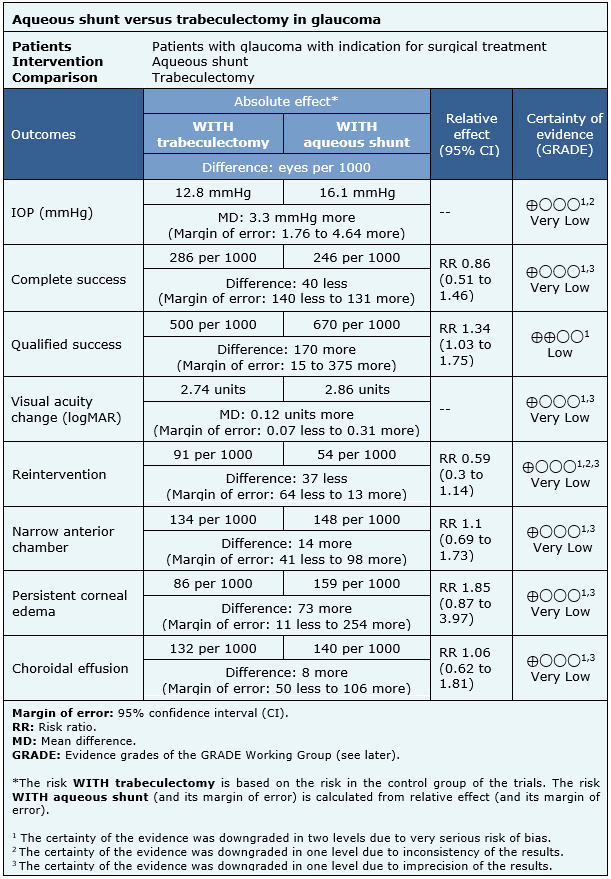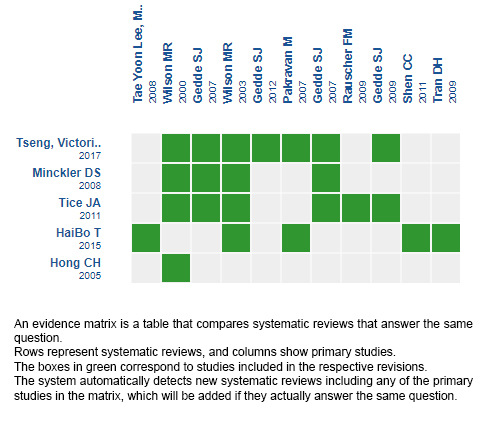Epistemonikos summaries
← vista completaPublished on December 19, 2018 | http://doi.org/10.5867/medwave.2018.08.7389
Aqueous shunt versus trabeculectomy for treatment of glaucoma
Derivación acuosa versus trabeculectomía para el manejo del glaucoma
Abstract
INTRODUCTION Aqueous shunt has emerged as an alternative technique to trabeculectomy, which is considered the standard treatment for glaucoma surgery. Currently, it is mainly indicated after failure of trabeculectomy or in some types of glaucoma with high risk of failure. However, there is still controversy regarding its effectiveness compared to trabeculectomy.
METHODS We searched in Epistemonikos, the largest database of systematic reviews in health, which is maintained by screening multiple information sources, including MEDLINE, EMBASE, Cochrane, among others. We extracted data from the systematic reviews, reanalyzed data of primary studies, conducted a meta-analysis and generated a summary of findings table using the GRADE approach.
RESULTS AND CONCLUSIONS We identified five systematic reviews including nine studies overall, of which four were randomized trials. We concluded that aqueous shunt might increase the qualified success compared to trabeculectomy, but it is not clear whether it has any effect on the rest of the critical outcomes for decision-making because the certainty of the evidence is very low.
Problem
According to the World Health Organization, glaucoma is the second cause of blindness worldwide. Among the risk factors for its development, intraocular pressure (IOP) is the only one that can be modified.
Since the end of the last century, the introduction of aqueous shunt has emerged as an alternative surgery to trabeculectomy. The aqueous shunt can be defined as a silicone tube with a lumen attached to an explant plate. Currently, its main indication is for glaucoma with failed trabeculectomy or in some types of glaucoma with a high risk of failure (for example, neovascular or uveitic glaucoma). Over the years, the use of aqueous shunt has spread, being currently chosen as primary surgery by many specialists. However, there is controversy about this last scenario.
Methods
We searched in Epistemonikos, the largest database of systematic reviews in health, which is maintained by screening multiple information sources, including MEDLINE, EMBASE, Cochrane, among others, to identify systematic reviews and their included primary studies. We extracted data from the identified reviews and reanalyzed data from primary studies included in those reviews. With this information, we generated a structured summary denominated FRISBEE (Friendly Summary of Body of Evidence using Epistemonikos) using a pre-established format, which includes key messages, a summary of the body of evidence (presented as an evidence matrix in Epistemonikos), meta-analysis of the total of studies when it is possible, a summary of findings table following the GRADE approach and a table of other considerations for decision-making.
|
Key messages
|
About the body of evidence for this question
|
What is the evidence. |
We found five systematic reviews [1], [2], [3], [4], [5] including nine primary studies reported in 16 references [6], [7], [8], [9], [10], [11], [12], [13], [14], [15], [16], [17], [18], [19], [20], [21], of which four correspond to randomized controlled trials, reported in 11 references [7], [8], [9], [10], [11], [12], [13], [16], [17], [20], [21]. However, one trial [16] was performed in pediatric population with aphakic glaucoma, which is not considered comparable with the rest of patients, so it was excluded from this analysis. This table and the summary in general are based on three randomized trials [10], [20], [21], since the inclusion of the observational studies did not increase the certainty of the evidence or added additional information. |
|
What types of patients were included* |
All trials included patients with glaucoma, with an average age of 53.9 years, of both genders, with average IOP of 25.96 mmHg (25.46 mmHg in the aqueous shunt arm, and 26.45 mmHg in the trabeculectomy arm). Regarding the type of glaucoma, one trial included patients with primary open-angle glaucoma, chronic angle-closure glaucoma, pseudoexfoliative glaucoma, pigmentary glaucoma [10], one trial included patients with primary open-angle glaucoma, primary angle-closure glaucoma, neovascular glaucoma, uveitic glaucoma and traumatic glaucoma [20] and one trial included primary open-angle glaucoma and angle-closure glaucoma [21]. In terms of the severity of glaucoma, all trials included patients with indication for surgical treatment [10], [20], [21]. One trial included patients both refractory to medical management and to surgical management (previous trabeculectomy, cataract extraction surgery, or both) [10]. One trial included patients refractory to medical management, and a proportion of patients refractory to surgical management (29.0% in the aqueous shunt arm, 43.6% in the trabeculectomy arm, without specifying the type of previous surgical intervention) [20]. One trial included only patients refractory to medical treatment, excluding patients with previous intraocular surgery [21]. |
|
What types of interventions were included* |
All trials compared aqueous shunt with trabeculectomy [10], [20], [21]. |
|
What types of outcomes |
The trials evaluated multiple outcomes, which were grouped by the systematic reviews as follows:
The average follow-up of the trials was 40 months, with a range between 12 and 60 months. |
* The information about primary studies is extracted from the systematic reviews identified, unless otherwise specified.
Summary of findings
The information about the effects of the use of aqueous shunts compared to trabeculectomy is based on three randomized trials involving 452 eyes [10], [20], [21].
All trials reported the mean intraocular pressure at the end of follow-up (320 eyes), change in visual acuity at one year (360 eyes), need of reintervention (452 eyes) and narrow anterior chamber (452 eyes) [10], [20], [21]. Two trials evaluated choroidal effusion (329 eyes) [10], [20]. Only one trial evaluated complete success at the end of follow-up (157 eyes), qualified success at the end of follow-up (157 eyes) and persistent corneal edema (212 eyes) [10].
The summary of findings is as follows:
- It is not clear the effect of aqueous shunt on intraocular pressure, compared to trabeculectomy, because the certainty of the evidence is very low.
- It is not clear whether the aqueous shunt decreases complete success compared to trabeculectomy, because the certainty of the evidence is very low.
- Aqueous shunt might achieve greater qualified success compared to trabeculectomy, but the certainty of the evidence is low.
- It is not clear whether the aqueous shunt leads to a greater deterioration in visual acuity compared to trabeculectomy, because the certainty of the evidence is very low.
- It is not clear whether aqueous shunt decreases the need of reintervention compared to trabeculectomy, because the certainty of the evidence is very low.
- It is not clear whether aqueous shunt increases the risk of narrow anterior chamber compared to trabeculectomy, because the certainty of the evidence is very low.
- It is not clear whether aqueous shunt increases the risk of persistent corneal edema compared to trabeculectomy, because the certainty of the evidence is very low.
- It is not clear whether aqueous shunt increases the risk of choroidal effusion compared to trabeculectomy, because the certainty of the evidence is very low.

| Follow the link to access the interactive version of this table (Interactive Summary of Findings – iSoF) |

Other considerations for decision-making
|
To whom this evidence does and does not apply |
|
| About the outcomes included in this summary |
|
| Balance between benefits and risks, and certainty of the evidence |
|
| Resource considerations |
|
| What would patients and their doctors think about this intervention |
|
|
Differences between this summary and other sources |
|
| Could this evidence change in the future? |
|
How we conducted this summary
Using automated and collaborative means, we compiled all the relevant evidence for the question of interest and we present it as a matrix of evidence.

Follow the link to access the interactive version: Aqueous shunt versus trabeculectomy for glaucoma
Notes
The upper portion of the matrix of evidence will display a warning of “new evidence” if new systematic reviews are published after the publication of this summary. Even though the project considers the periodical update of these summaries, users are invited to comment in Medwave or to contact the authors through email if they find new evidence and the summary should be updated earlier.
After creating an account in Epistemonikos, users will be able to save the matrixes and to receive automated notifications any time new evidence potentially relevant for the question appears.
This article is part of the Epistemonikos Evidence Synthesis project. It is elaborated with a pre-established methodology, following rigorous methodological standards and internal peer review process. Each of these articles corresponds to a summary, denominated FRISBEE (Friendly Summary of Body of Evidence using Epistemonikos), whose main objective is to synthesize the body of evidence for a specific question, with a friendly format to clinical professionals. Its main resources are based on the evidence matrix of Epistemonikos and analysis of results using GRADE methodology. Further details of the methods for developing this FRISBEE are described here (http://dx.doi.org/10.5867/medwave.2014.06.5997)
Epistemonikos foundation is a non-for-profit organization aiming to bring information closer to health decision-makers with technology. Its main development is Epistemonikos database (www.epistemonikos.org).
Potential conflicts of interest
The authors do not have relevant interests to declare.

